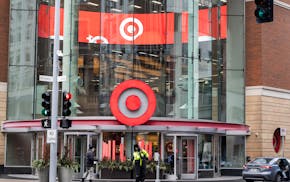I believe President Donald Trump's trade war will drive the U.S. and perhaps the world into recession. It's terrible and unnecessary.
Nearly everyone in business is talking about this possibility — and so probably are your relatives and friends. I first wrote my fears about this in July, when it seemed clear to me Trump would win the November election.
You can find all kinds of commentary about Trump's old-fashioned, zero-sum views about the economy. My focus remains on Minnesota's economy and businesses; I've written more than once that our state was particularly vulnerable to Trump's tariffs and restrictions on immigration.
Minnesota has farmers, transportation and medtech industries that rely heavily on exports and retailers like Target and Best Buy that are major importers.
The mystery now isn't how badly Minnesotans will be hurt by Trump, but how we'll respond.
Will Minnesota's operating model — a state with services "more like Nordstrom than Walmart," as I once heard a legislator put it — be the same on the other side of the Trump downturn? Will Minnesotans' political preferences continue lurching to the right or will there be a backlash against Trump and Republicans spurred by the economic pain?
Even before Trump on April 2 expanded his trade war with tariffs that go beyond those of the Smoot-Hawley period in the 1930s, Minnesota Democrats were blaming him for the difficulties facing the state government's budget. The DFLers were not entirely wrong, but they elided their own culpability in spending much of a surplus the state possessed two years ago.
As we plunge into this great unknown, let's take a measure of Minnesota's economy and put down a marker to look back on later this year or next.
Start with employment, where the state has looked strong. Minnesota's unemployment rates after the pandemic have been some of the lowest in the country, and the labor participation rate has been among the highest in the country. The state has been a top 5 performer in both: at 3% unemployment and 68% participation in February.
That means we haven't had many people sitting on the sidelines and immigrants have not pushed Minnesotans out of jobs.
Indeed, a report published late last month by the Department of Employment and Economic Development, citing Pew Research data, said undocumented immigrants accounted for just over 1.5% of Minnesota's population, less than half the 3.3% level of the country as a whole.
That figure was for 2022, so it doesn't include a likely increase in 2023 nor the likely decline of 2024, based on border crossing figures.
On exports, Minnesota had a terrific year in 2024. The value of exports grew 7% to $27 billion, beating the nation's export growth rate of 2%. Minnesota ranked 23rd among states for exports, but we should expect to be a little better as the country's 22nd most populous state.
The troublesome area has been overall economic growth. Minnesota's real GDP, which adjusts for inflation, grew 1.1% last year, well below the nation's growth rate of 2.8%.
We had the 43rd-best-performing economy among the 50 states, and that's only because of a strong fourth quarter that actually beat the nation's overall performance. Through the first nine months of 2024, Minnesota's economy ranked 47th.
With that, Minnesota has grown more slowly than the nation as a whole for 10 straight years. What's more, the right-leaning Center for the American Experiment has documented that Minnesota's per capita GDP has fallen below the nation's, giving up a "premium" that once distinguished the state as exceptionally wealthy for its size.
In the days before Trump's tariff shock began to dominate attention, I read "Abundance," the new book by left-leaning journalists Ezra Klein and Derek Thompson that diagnoses why states like Minnesota that have long been led by Democrats haven't been able to get stuff done.
As blue states go, Minnesota hasn't reached the extreme level of unaffordability, housing shortages and degrading infrastructure of California, which gets a lot of attention in the book. I sometimes describe Minnesota's problems as "California-lite."
For instance, while California has spent tens of billions on a high-speed rail that hasn't completed a single mile, we're only a couple billion dollars over budget on the delayed extension of Twin Cities light rail into the southwest suburbs. And while Minneapolis has gotten applause nationally for encouraging more housing by eliminating single-family zoning, St. Paul arrested construction with its rent control.
Klein and Thompson write that liberal governments tend to try to solve too many things, often by tacking on new goals or restrictions to a project that raise costs and reduce the likelihood it will get done.
There are many examples of this in Minnesota, but one of my favorites is in Morris, where separately run child care operations share a building to save costs. For some reason, the state required each to have its own playground, raising costs.
Minnesota isn't mentioned in the book. I tracked the authors' promotional interviews since the book was released last month, and Minnesota came up a few times as an example of a blue state that lost population after the pandemic. The population actually declined in just one year since 2020, but Minnesota's population growth has been well below the nation's for many years.
Unfortunately, the solutions Klein and Thompson — along with some other recent writers in what's become known as the "abundance movement" — offer for blue states like Minnesota are threatened by Trump's belief that scarcity animates the world and tools like tariffs are needed to survive.
"The right is abandoning many of its successes to embrace a politics of scarcity," Klein and Thompson wrote. "That has left room for liberals to embrace what Republicans have abandoned: a politics of abundance."

Ramstad: Minneapolis' Camden neighborhood is rising. Houston White wants to keep it that way.

Ramstad: Minnesota's big businesses are in crisis with a common problem

Ramstad: No business can 'eat' all the tariffs, not even Walmart

Ramstad: Donaldson is protected from tariff chaos after expanding globally the right way


